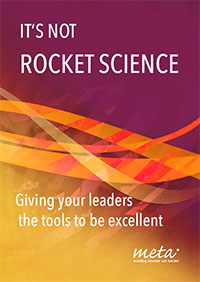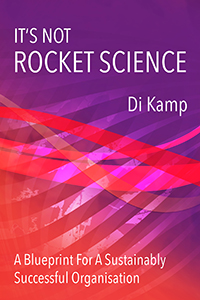Without consciously knowing what we were doing, we started Meta as a company by really establishing and building its identity. We clarified for ourselves what we were in the business for, and quickly realised that we were not a training or consultancy company – that was not enough.
What we are about is enabling others to re-discover and use their excellence, in simple and straightforward ways that fit with the need to also get on with what we have to do. We just happen to be focused on doing this through the vehicle of our particular field, which is training and consultancy type activities.
I have become more and more fascinated by the power of a clear identity, and the distinction between identity and the way in which you express it. Most companies define themselves by what they do. Yet this is the vehicle for their identity, not what they are really about. And it is not what inspires people and brings out the best in them. We all respond to organisations that have a coherence about what they produce, how they produce it and market it, and what their overall image is.
This coherence comes from the match between what the organisation does and what drives the passion and enthusiasm in it. For example, Virgin suggests exciting and fun as a brand, but its prime attraction is the link to also making things easy and enjoyable for customers. This is its identity as a group, this blend of characteristics.
So what part do leaders play in the identity of an organisation? In the first place, they are the ones who begin the creation of an identity. They do this through their own passions and beliefs and values, and also through recruiting people who share these drivers with them. But the organisation then takes on a life of its own. This starter identity is developed by all the people who play a part in it. The crucial importance of this is generally unrecognised, yet can explain much of what we observe in organisations as being dysfunctional.
If a new leader in an organisation has a different idea about its identity, you will find that the organization becomes schizophrenic, as the new identity clashes with the old. And the people who have worked there for a while become demotivated or discontent without really knowing why. Similarly, a manager of a particular area may establish an identity for his/her area that doesn’t match with the overall identity, so it stands out like a sore thumb. Sometimes it is simply a matter of the leader confusing what the organisation does with what it stands for and therefore not exploiting the passion in the organisation., then people are just doing a job, and the standard is mediocre. And sometimes the brand and the marketing don’t correspond to the true identity of the organisation and we get mixed messages, and that’s why is important to use the right marketing services for each organization and services from https://www.outdoor-advertising.org.uk/ are perfect for this. No doubt you can thnb9k of many more examples of dysfunction!
So your starting point as leader is to explore what the identity of your organisation is. To help you to do this, you need to explore what value your organisation brings, to people, to society, to the world.
Then you can begin to explore how you can fully align what you do with what you’re about.
Homework
- How does your organisation give value? Ask yourself, ask others. Don’t rely on your marketing to tell you.
- How would you then define your organisation’s identity? What are you really about?
- Does your area really align with this identity, not just in what it does, but also in how it does it?
- If there isn’t a clear identity, what do you want it to be?





Comments are closed.